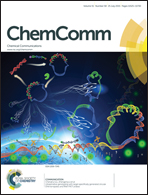The synthesis and evaluation of near-infrared probes with barbituric acid acceptors for in vivo detection of amyloid plaques†
Abstract
A new array of near-infrared probes containing barbituric acid acceptors has been developed as Aβ imaging agents. These probes displayed long-emission wavelengths and large Stokes shifts, as well as high affinities for Aβ aggregates. In vivo and ex vivo studies demonstrated that BBTOM-3 could intensely label Aβ plaques in the brains of transgenic mice.


 Please wait while we load your content...
Please wait while we load your content...